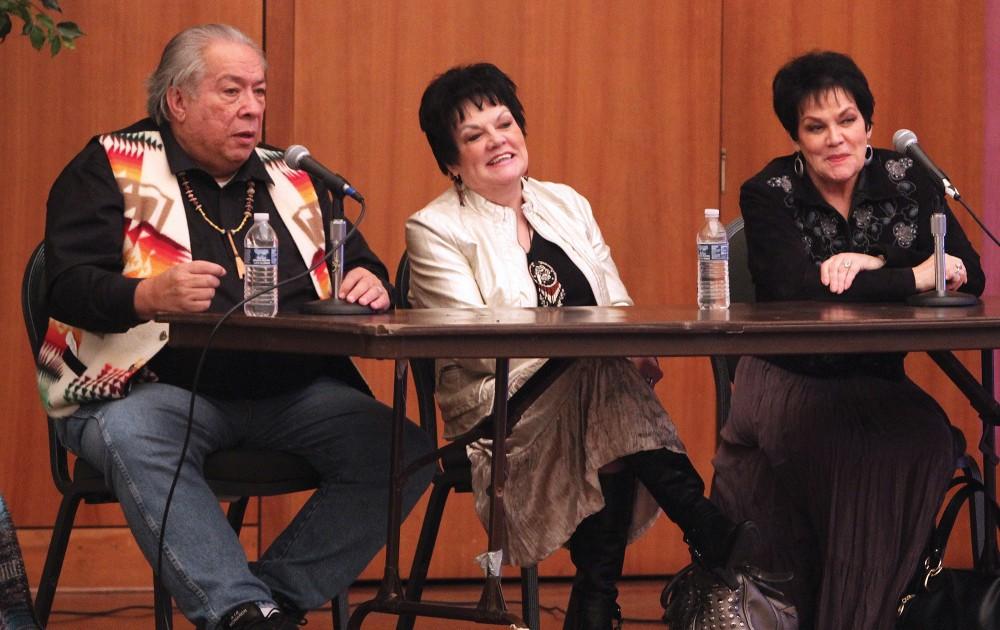Surviving school

GVL / Laine Girard (Left )Warren Petoskey, (Middle) Kay McGowen, and (Right) Fay Givens speak to students on Native American Heritage Month. During this discussion they talked about the celebration of the history, culture, traditions and contributions of native americans and emphasized how important it was to keep this tradition present in our society.
Nov 11, 2013
Students and community members gathered Thursday at Grand Valley State University to learn about the Native American boarding school experience through a documentary film and panel discussion as part of Native American Heritage Month.
The Office of Multicultural Affairs sponsored the event, which showcased “Indian School: A Survivor’s Story.” The documentary was created in 2011 and includes archives and interviews with Native Americans who experienced life at a boarding school in Mount Pleasant, Mich., which opened in the late 19th century and operated until 1934.
Warren Petoskey, a local artist and author, attended the boarding school and remembers it was a “hostile” environment, where he was taught to believe terms he saw in the history book like “savage,” “pagan,” “heathen” and “godless.”
Eventually, Petoskey was able to reject these ideas and ask questions to find out the truth about his culture and his people.
The boarding school in Mount Pleasant was just one of the schools that was created across the country as part of a federal government initiative that forced indigenous people to attend boarding schools to receive an education.
The film quoted Richard Pratt, the founder of one of the first boarding schools in Carlisle, Penn., who said the goal was to “kill the Indian but save the man.” Other boarding schools were based on this philosophy of assimilating Native Americans into mainstream white culture, which was seen as the solution to the “Indian problem.”
Kay McGowan, professor of Anthropology and Sociology at Eastern Michigan University, said the real goal of these schools was to “keep them as an underclass,” teaching them English and how to work in a domestic setting.
McGowan said the Carlisle School in Pennsylvania had about 10,000 students attend, but less than 800 graduate. Attempts at assimilating the children only marked the beginning of the loss of native languages and culture.
The film also showed the violent treatment of Native American students, who were often physically and sexually abused. Many even died without their parents being told and were buried in unmarked graves. In addition, many young girls were forcibly sterilized while at the boarding schools.
“Today, we see it as a gross violation of human rights,” McGowan said. “It was a horrible experiment by the U.S. government. It was an attempt to destroy us as a native people.”
After students left the schools, they still faced discrimination, inequality and unemployment. Conditions on Native American reservations were also poor, including low life expectancy because of high suicide rates and alcohol abuse.
According to the film, these social problems are examples of “inter-generational trauma” that are passed on from one generation to the next.
“Inter-generational trauma is trauma that isn’t dealt with in the generation it is found,” McGowan said. “We didn’t anticipate the pain that was going to come from this experience of making the movie.”
Petoskey said inter-generational trauma is layered, and it began with the invasion of America and continued with the boarding school system and the relocation of Native Americans to reservations. The forced sterilizations added another layer.
Fay Givens, executive director of the American Indian Services, said the main goal is to “try to keep our people together.”
One way to do this is through an international agreement called the Declaration on the Rights of Indigenous People, which Givens is currently working on with McGowan. The project was accepted by the U.N. General Assembly in 2007, but Givens said more still needs to be done.
In September 2014, Givens and McGowan will present the topic at a world conference to increase knowledge of the issue. They will ask for a full investigation of American boarding schools and for the U.S. to apologize and take responsibility for what happened.
Petoskey agreed that the world needs to know the truth. He told the audience they are the “generation coming,” meaning they need to be “conscious, responsible and determined” to make changes in society.
“My prayer and hope is that you will be an activist in propelling this truth forward,” Petoskey said. “You know who’s going to change this—you are.”
For more information about Native American Heritage Month events, visit www.gvsu.edu/oma/native-american-heritage-month-139.htm.






















